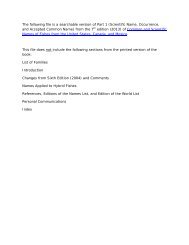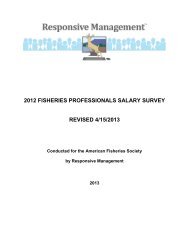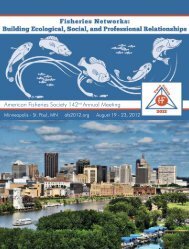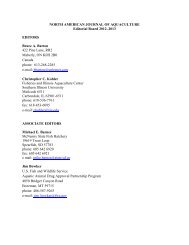Conservation Status of Crayfish Species Paddlefish Conservation ...
Conservation Status of Crayfish Species Paddlefish Conservation ...
Conservation Status of Crayfish Species Paddlefish Conservation ...
Create successful ePaper yourself
Turn your PDF publications into a flip-book with our unique Google optimized e-Paper software.
nAtionAl Fish hAbitAt<br />
Action plAn<br />
In April, the first anniversary <strong>of</strong> the launch<br />
<strong>of</strong> the National Fish Habitat Action<br />
Plan (NFHAP) was celebrated with the<br />
unveiling <strong>of</strong> “10 Waters to Watch,”<br />
which collectively illustrate the promising<br />
partnerships at the heart <strong>of</strong> this<br />
program. These 10 waters are bringing<br />
together community groups, non-pr<strong>of</strong>it<br />
organizations, local watershed groups,<br />
Native American tribes, and state and<br />
federal agencies to plant streamside<br />
vegetation, remove structures blocking<br />
fish from accessing habitat, and protect<br />
rivers from the effects <strong>of</strong> agriculture and<br />
livestock. The idea is to provide clean<br />
water and robust, healthy habitats for<br />
the many fish and wildlife species and<br />
people who call these areas home.<br />
NFHAP currently supports 40 local,<br />
grassroots-driven projects, like those on<br />
the Waters to Watch list, as well as U.S.<br />
national efforts to identify the root causes<br />
<strong>of</strong> aquatic habitat declines, identify<br />
and implement corrective actions, and<br />
measure and communicate its progress.<br />
Projects in the “10 Waters to Watch” are<br />
being coordinated through five “National<br />
Fish Habitat Partnerships” and organized<br />
as regional-scale efforts to implement<br />
NFHAP. These regional partnerships<br />
are currently “pilots” that include the<br />
Southeast Aquatic Resources Partnership,<br />
Eastern Brook Trout Joint Venture, the<br />
Western Native Trout Initiative, the<br />
Midwest Driftless Area Restoration<br />
Effort, and the Matanuska-Susitna Basin<br />
Salmon <strong>Conservation</strong> Partnership. The<br />
plan calls for the creation <strong>of</strong> 12 or more<br />
Fish Habitat Partnerships by 2010.<br />
2007 AFs-seA GrAnt symposium<br />
The American Fisheries Society and<br />
Sea Grant continue their biennial series<br />
<strong>of</strong> special symposia with “Mitigating<br />
Impacts <strong>of</strong> Natural Hazards on Fishery<br />
Ecosystems.” The symposium, which will<br />
be held at this year’s Annual Meeting<br />
in San Francisco, will explore how to<br />
better mitigate the impacts <strong>of</strong> natural<br />
hazards on fish populations, fish habitat<br />
and fishing communities. An associated<br />
proceedings volume will be<br />
published early next year for use by<br />
AmericAn Fisheries society:<br />
2007 REPoRt<br />
special projects<br />
fisheries pr<strong>of</strong>essionals hoping to be better<br />
prepared for the next hazard event.<br />
Here, natural hazards are defined as<br />
sudden events which can lead to rapid,<br />
significant ecosystem impacts <strong>of</strong> various<br />
geographic scopes. Such events can be<br />
characterized as producing large impact<br />
(biological, economic and social),<br />
and occurring with little or no warning.<br />
Hazards that will be discussed during our<br />
symposium include hurricanes and other<br />
coastal storms, earthquakes, tsunamis,<br />
volcanoes, harmful algal blooms, and<br />
localized or regional anoxic events.<br />
Researchers will discuss their work as<br />
well as lessons learned from well-known<br />
hazard events such as the 2004 Indian<br />
Ocean tsunami and Hurricanes Katrina<br />
and Rita, in addition to smaller scale<br />
hazards that occur on a more regular<br />
basis, such as harmful algal blooms <strong>of</strong>f<br />
the Florida coast. A synthesis piece<br />
and moderator-led audience participation<br />
discussion will close out the session<br />
to draw out common themes from the<br />
hazards discussed. A total <strong>of</strong> 32 presentations<br />
will occur over the 2-day symposium<br />
(5-6 September), in addition to 5<br />
posters. More information is available at<br />
www.fisheries.org/units/afs-sgsymposium.<br />
FiFth worlD Fisheries<br />
conGress plAnninG<br />
Planning is well underway for the Fifth<br />
World Fisheries Congress (WFC), which<br />
will be held in Yokohama, Japan, from<br />
20-24 October 2008. The goal <strong>of</strong> WFC<br />
meetings is to convene fisheries scientists<br />
from around the world to discuss<br />
and bring attention to the primary issues<br />
facing global fisheries. The 5 th WFC<br />
is being organized by the Japanese<br />
Society <strong>of</strong> Fisheries Science (JSFS) as<br />
the lead society, and members <strong>of</strong> the<br />
World Council <strong>of</strong> Fisheries Societies are<br />
also included in the program planning.<br />
AFS has been heavily involved in<br />
the program planning for the 5 th WFC<br />
and many <strong>of</strong> the priorities that AFS has<br />
brought to the WFC program planning<br />
committee have been incorporated into<br />
what will be an excellent WFC program.<br />
The objective <strong>of</strong> the 5 th WFC is to address<br />
issues that contribute to the global<br />
welfare and environmental conservation<br />
<strong>of</strong> the world’s fisheries. WFC will be<br />
organized around nine topical sessions,<br />
which include fisheries and fish biology;<br />
aquaculture; biotechnology; post-harvest<br />
science and technology; material<br />
cycling in aquatic ecosystems—linking<br />
climate change and fisheries; freshwater,<br />
coastal, and marine environments;<br />
biodiversity and management; fisheries<br />
economics and social science; and<br />
education and international cooperation.<br />
Under each topical session, a series<br />
<strong>of</strong> subsessions will be developed to<br />
address specific issues surrounding each<br />
topic. There also will be an open call for<br />
papers during the fall <strong>of</strong> 2007, for those<br />
wishing to submit papers for possible<br />
inclusion into the program. The 5 th WFC<br />
will be held at the Pacifico Yokohama<br />
convention center, a short bus or train<br />
trip from Tokyo and Narita International<br />
Airport. For more details on the 5 th WFC,<br />
please see www.5thwfc2008.com.<br />
hutton upDAte<br />
The Hutton Junior Fisheries Biology<br />
Program is a summer mentoring program<br />
for high school students. The principal<br />
goal <strong>of</strong> the Hutton Program is to stimulate<br />
interest in careers in fisheries science and<br />
management among groups underrepresented<br />
in the pr<strong>of</strong>ession, including<br />
minorities and women. Hutton provides<br />
students with a summer-long hands-on<br />
experience in fisheries research with a<br />
mentor who is working in some aspect<br />
<strong>of</strong> the field. A scholarship and an AFS<br />
student membership are provided<br />
to each student accepted into the<br />
program. The Class <strong>of</strong> 2007 includes<br />
36 outstanding students who worked<br />
with more than 40 mentors in 21 states<br />
(Alaska, Arizona, California, Colorado,<br />
Connecticut, Hawaii, Idaho, Illinois,<br />
Kansas, Maryland, Michigan, Missouri,<br />
Montana, Nebraska, New York, North<br />
Carolina, Tennessee, Texas, Virginia,<br />
Washington, Wisconsin). As in past<br />
years, the group <strong>of</strong> student applicants<br />
was ethnically diverse. A majority <strong>of</strong> the<br />
selected students were either women<br />
and/or were from a minority group.<br />
The program is evaluated annually<br />
through a survey <strong>of</strong> all previous alumni.<br />
The ultimate success <strong>of</strong> the program<br />
will be determined by the number <strong>of</strong><br />
students that enter the fisheries pr<strong>of</strong>ession.<br />
According to the 2006 survey, 78%<br />
<strong>of</strong> alumni are studying or considering<br />
studying fisheries or biology. The 2007 survey<br />
is currently underway, and the results<br />
will be printed in Fisheries this winter.<br />
Fisheries • vol 32 no 8 • august 2007 • www.fisheries.org 407







